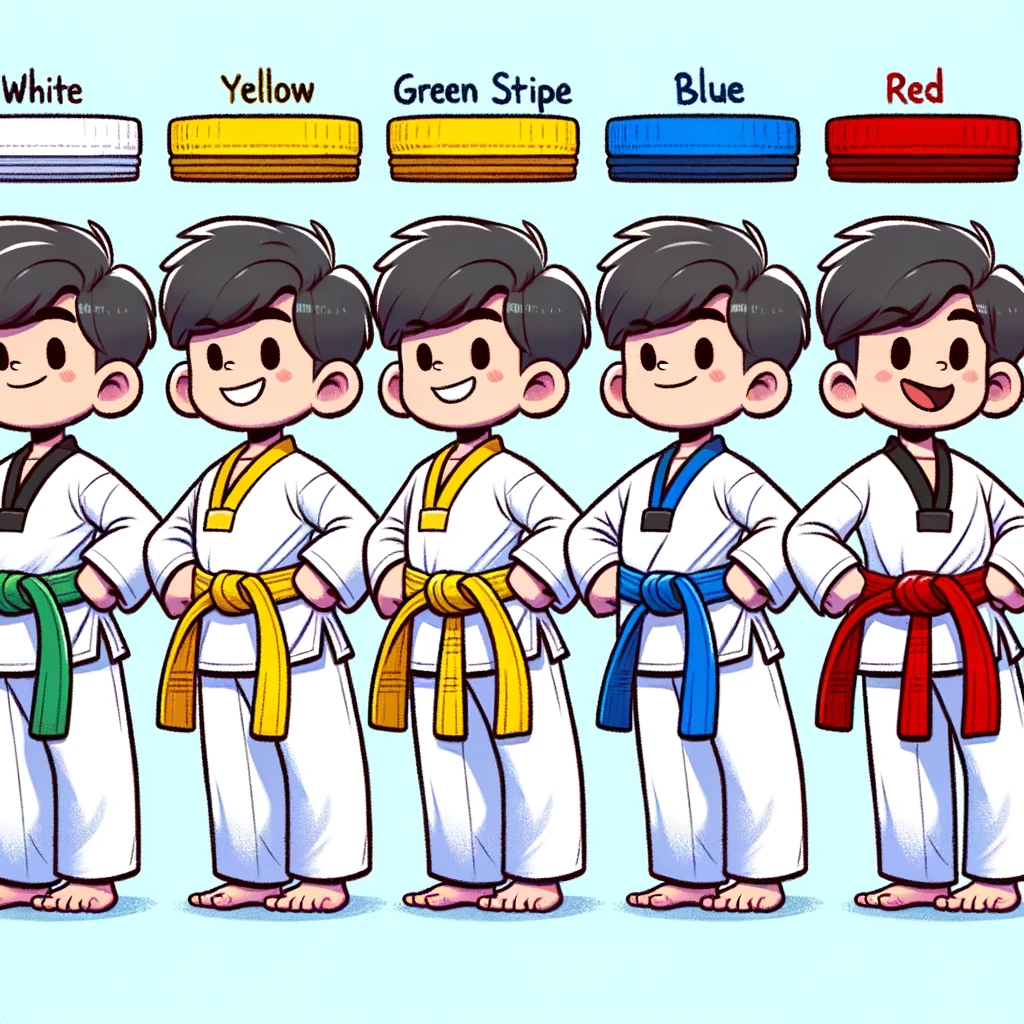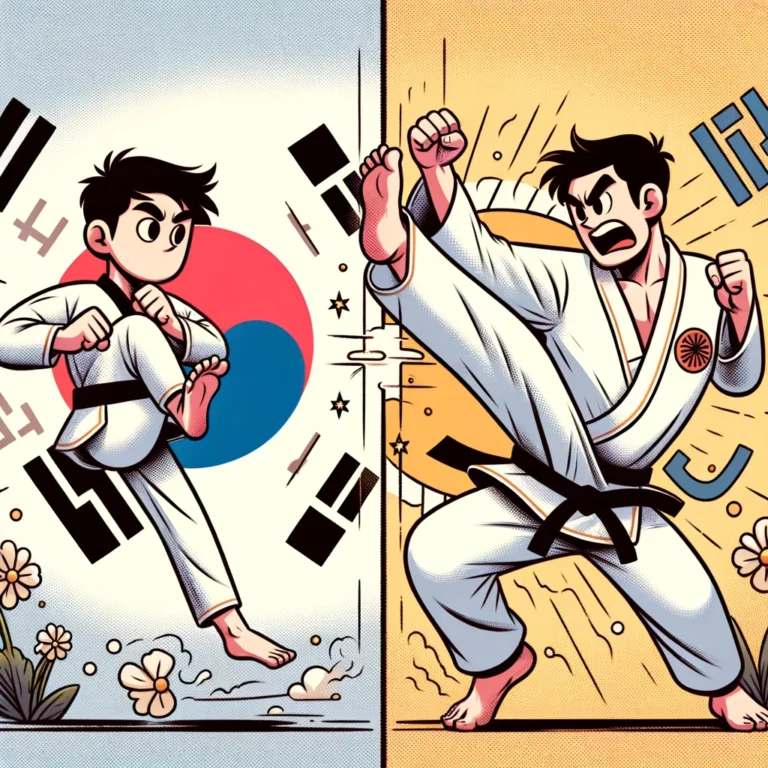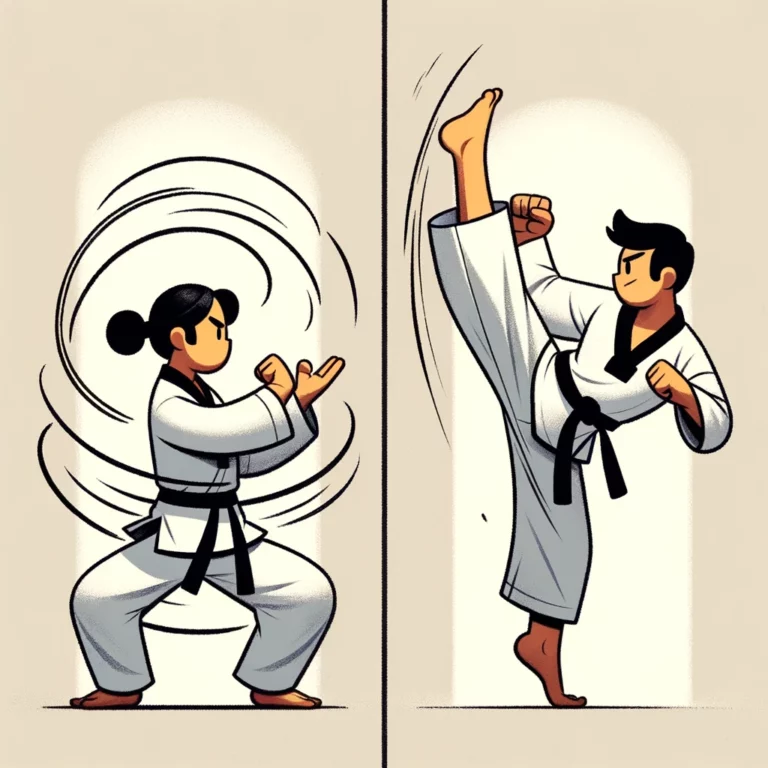What is the Order of Belts in Taekwondo? Here, we delve into the structured progression system that symbolizes a practitioner’s expertise and mastery in Taekwondo. This introductory guide aims to shed light on the significance of each belt colour, marking milestones in a martial artist’s journey from novice to master. Whether you’re new to Taekwondo or looking to understand the path ahead, join us as we explore the colourful journey through the ranks of this ancient martial art.
White Belt: The Starting Point in Taekwondo Journey
The white belt is the first step on the taekwondo journey, symbolising a beginner’s entry into this martial art. It is a blank canvas, representing a fresh start and unlimited potential for growth and development. Students at this level are introduced to Taekwondo’s basic principles and fundamental techniques, laTaekwondorong foundation for future progress. The white belt phase mainly focuses on building physical fitness, flexibility, and coordination.
In addition to the physical aspects, the white belt also introduces students to Taekwondo’s mental and philosophical aspects. Taekwondo respect and perseverance are emphasised, forming the core values that go hand in hand with the physical techniques. Through these values, practitioners begin to understand the true essence of Taekwondo, which is a mere physical movement. The white belt stage is an essential phase of the taekwondo journey, setting the stage for the challenges and achievements. Through dedication and consistent practice, students gradually progress to the next level, ready to face new obstacles and embrace the exciting journey of Taekwondo.

Yellow Stripe Belt: Progressing from White Belt.
The Yellow Stripe Belt is the next step in mastering Taekwondo. Taekwondo indicates progress and growth from the White Belt stage. As students move into this level, they develop a deeper understanding of the techniques and principles they have been learning. This stage focuses on building a solid foundation of the basic movements and stances and mastering the fundamental kicks and punches. With each class, students become more confident in their abilities and gain a sense of accomplishment as they see their skills improve.
The Yellow Stripe Belt also introduces students to more complex forms and patterns called Poomsae. Poomsae is a sequence of choreographed movements that simulate a real fight scenario. This allows students to link their techniques together in a fluid and controlled manner, helping to refine their coordination and timing. The practice of Poomsae helps students develop discipline, concentration, and precision. With regular training, students continue to refine their techniques and progress towards their ultimate goal of becoming a proficient martial artist.
Overall, the Yellow Stripe Belt signifies significant progress from the beginner level. It is a stepping stone towards becoming a well-rounded Taekwondo practitioner. With discipline, perseverance, and dedication, students can continue to progress and achieve higher levels of mastery in this ancient martial art.
Yellow Belt: Advancing Further in Taekwondo
As students progress from the white belt to the yellow belt in Taekwondo, they are confronted with new challenges and opportunities for growth. This belt signifies their advancement and commitment to furthering their skills in the martial art. At the yellow belt level, practitioners delve deeper into the techniques and principles of Taekwondo, but Taekwondo is the foundation established in earlier stages.
One of the critical areas of focus during the Yellow Belt journey is refining basic techniques. Students continue to practice fundamental movements, such as punches, kicks, and blocks, but with a greater emphasis on precision and efficiency. They learn to generate power from their core and develop better control over their body movements. Additionally, they explore the different striking surfaces of the hands and feet, learning to strike with the knuckles, palms, and various foot parts. Through consistent practice and repetition, yellow belt students develop a more refined and robust execution of their techniques.
In addition to honing their physical skills, Yellow Belt practitioners also deepen their understanding of Taekwondo’s philosophies and values, such as the importance of discipline, respect, and perseverance, which are essential in martial arts and daily life. Students are encouraged to embody these principles inside and outside the dojang, fostering a sense of responsibility and integrity. As they advance further in Taekwondo, students begin to see the integration of these moral values in their training, enhancing their overall development as martial artists and individuals.
– In the next stage of their taekwondo journey, green stripe belt, students will continue to build upon the foundation set in the yellow belt level, further refining their skills and advancing towards mastery.
– The yellow belt serves as a stepping stone towards higher levels in Taekwondo, allowing Taekwondomo students to persevere and embrace the challenges in their martial arts journey.
– As yellow belt practitioners progress in Taekwondo, Taekwondolop becomes confident in their abilities and deeply appreciates the art form.

Green Stripe Belt: Building Skills and Confidence
The Green Stripe Belt is a significant milestone in the journey of a taekwondo practitioner. Students are focused on building their physical skills and confidence in performing various techniques at this stage. The emphasis is on refining stances, kicks, and strikes and mastering the fundamental movements that form the backbone of Taekwondo. Taekwondodors have also started to develop a deeper understanding of the philosophical aspects of martial arts, such as discipline, respect, and perseverance.
With each training session, students better understand their strengths and weaknesses. They learn to push themselves beyond their comfort zones while maintaining a solid foundation. The Green Stripe Belt curriculum encompasses various exercises and drills that challenge students to enhance their flexibility, coordination, and agility. Through regular practice, they begin to feel more in control of their bodies and acquire the ability to execute techniques with precision and efficiency. This growing competence nurtures their confidence, motivating them to continue their taekwondo journey with determination and a thirst for knowledge.
Green Belt: Demonstrating Proficiency in Taekwondo Techniques
Achieving the Green Belt in Taekwondo signifies a significant milestone in a practitioner’s journey. It is a testament to their dedication, hard work, and commitment to the art. At this stage, students are expected to have a solid foundation in fundamental techniques and a growing understanding of the principles behind them.
One key aspect of being a Green Belt is demonstrating proficiency in various Taekwondo techniques. This includes a range of kicks, strikes, blocks, and combinations. Practitioners must display accuracy, precision, and control in their execution, showing technical proficiency and understanding of proper body mechanics. As they progress, Green Belt students will refine their techniques, honing their skills to become more fluid, powerful, and effective. With each new technique learned, they deepen their knowledge of Taekwondo and a stronger connection between their mind and body.
• Students must demonstrate proficiency in various kicks, including front, roundhouse, side, and back kicks.
• They should also be able to execute punches and palm strikes accurately and precisely.
• Green Belt students must show competence in blocking techniques to defend against attacks from opponents effectively.
• Combinations of these techniques are also expected to be performed seamlessly, showcasing the practitioner’s ability to transition smoothly between different moves.
• Proper body mechanics are crucial for executing Taekwondo techniques correctly. Green Belt students should understand how their body movements generate power and maximise efficiency.
• As they progress towards higher belts, Green Belts will continue refining their techniques by focusing on speed, strength, balance, and timing.
• Proficiency in Taekwondo techniques demonstrates technical skill and reflects the practitioner’s discipline and dedication to mastering the art form.

Blue Stripe Belt: Refining Techniques and Gaining Depth
After mastering the Green Belt level, taekwondo practitioners advance to the Blue Stripe Belt. This stage is characterised by a deeper refinement of techniques and a more profound understanding of Taekwondo’s tactical aspects. The Blue Stripe Belt signifies a student’s commitment to pursuing excellence in their martial arts journey and readiness to tackle more complex challenges.
At the Blue Stripe Belt level, students work on perfecting their existing skills while learning more advanced techniques. Their training includes complex combinations and a heightened focus on precision and power. Students also begin to understand the strategic elements of Taekwondo, such as distance management, timing, and the application of techniques in sparring situations. This level requires a more significant mental discipline as students must think critically about their movements and strategies.
Blue Belt: Demonstrating Advanced Skill and Strategy
Earning the Blue Belt is a testament to a practitioner’s dedication and skill. At this level, students have a strong foundation in Taekwondo and are ready to demonstrate advanced techniques and a strategic understanding of the art. The Blue Belt is not just about physical ability; it also represents mental growth and a deeper connection to Taekwondo’s philosophy.
Students at this level are expected to perform advanced kicking techniques with accuracy and power, including jumping and spinning kicks. They must also demonstrate advanced hand techniques and a solid defence strategy. Blue Belt students are encouraged to develop their style, incorporating their strengths into their taekwondo practice. The training becomes more rigorous, emphasising endurance, strength, and agility. Students are also expected to demonstrate leadership and mentorship within their dojang, helping lower-belt students in their taekwondo journey.
Red Stripe Belt: Approaching Mastery
As students progress to the Red Stripe Belt, they are approaching mastery of Taekwondo. This level is characterised by an emphasis on refining and perfecting all learned techniques. Students at this stage are polishing their skills to a high level of precision and are expected to fully understand each movement’s intricacies.
Red Stripe Belt students focus on advanced poomsae, demonstrating fluidity, power, and grace in their forms. They also prepare for more intense sparring, developing strategies and reflexes to serve them in high-level competitions. This level requires a solid commitment to training as the techniques and combinations become more challenging and demanding.
Red Belt: Mastery and Leadership
Achieving the Red Belt signifies that a student has nearly mastered the art of Taekwondo. Students at this level are expected to display a high degree of technical skill, strategic thinking, and leadership within the taekwondo community. The Red Belt is a leader, mentor, and role model to lower belt students, embodying the discipline, respect, and perseverance taekwondo teaches.
Red Belt students continue to refine their techniques, focusing on speed, power, and precision. They are also deepening their understanding of Taekwondo’s philosophical aspects, embodying the art’s values in their daily lives. At this stage, students are often involved in teaching, passing on their knowledge and experience to others and helping to foster a supportive and thriving taekwondo community.
Black Belt: The Journey Continues
Reaching the Black Belt is a significant achievement in the taekwondo journey, but it is not the end. It represents a new beginning, a commitment to lifelong learning, and continuous improvement. Black Belt practitioners are recognised for their expertise, dedication, and contributions to the art of Taekwondo.
Black Belts continue to train and refine their skills but also take on more significant roles in teaching and leading within their communities. They are seen as ambassadors of Taekwondo, promoting the art’s values and benefits to others. While the Black Belt symbolises mastery, it is also a reminder that the journey of learning and growth never truly ends. Each practitioner’s taekwondo journey is unique, and the Black Belt is a milestone that marks the dedication, hard work, and passion that have led them to this point—and that will continue to guide them in the future.

What is the starting point in a Taekwondo journey?
The starting point in a Taekwondo journey is the White Belt level.
What happens after the White Belt level in Taekwondo?
Taekwondodohite Belt level, practitioners progress to the Yellow Stripe Belt.
How does one advance further in Taekwondo after the aftTaekwondollow Stripe Belt?
Advancement in Taekwondo cTaekwondodoth the Yellow Belt level.
What does the Green Stripe Belt signify in Taekwondo?
Taekwondodotripe Belt signifies a stage where practitioners focus on building skills and confidence.
What is the final belt level in Taekwondo?
Taekwondoodoelt level in Taekwondo is the Taekwondo Belt, where practitioners demonstrate proficiency in techniques.
How can one demonstrate proficiency in Taekwondo techniques?
Demonstrating proficiency in Taekwondo techniques involves displaying a thorough understanding and execution of a wide range of techniques, including strikes, kicks, blocks, and forms.
What are some fundamental techniques that a Green Belt should be proficient in?
A Green Belt should be proficient in roundhouse kicks, back kicks, spinning kicks, palm-heel strikes, and knife-hand strikes, among others.
How long does it usually take to reach the Green Belt level in Taekwondo?
To reach the Green Belt level, Taekwondo can vary depending on an individual’s dedication and training frequency. Still, it typically takes several months to a year or more.
Can one participate in competitions as a Green Belt?
Yes, as a Green Belt, practitioners can participate in Taekwondo competitions and showcase their skills and proficiency in a competitive setting.
What is the next step after achieving the Green Belt in Taekwondo?
After achieving the Green Belt, practitioners can continue their journey to higher belt levels, such as the Blue Belt, Red Belt, and beyond.







